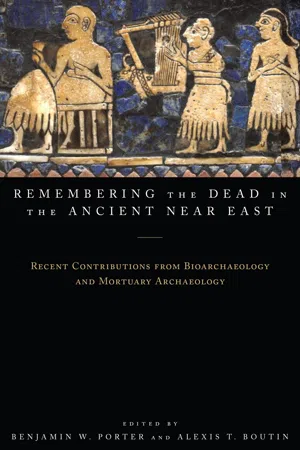
Remembering the Dead in the Ancient Near East
Recent Contributions from Bioarchaeology and Mortuary Archaeology
- English
- ePUB (mobile friendly)
- Available on iOS & Android
Remembering the Dead in the Ancient Near East
Recent Contributions from Bioarchaeology and Mortuary Archaeology
About this book
Remembering the Dead in the Ancient Near East is among the first comprehensive treatments to present the diverse ways in which ancient Near Eastern civilizations memorialized and honored their dead, using mortuary rituals, human skeletal remains, and embodied identities as a window into the memory work of past societies.
In six case studies teams of researchers with different skillsets—osteological analysis, faunal analysis, culture history and the analysis of written texts, and artifact analysis—integrate mortuary analysis with bioarchaeological techniques. Drawing upon different kinds of data, including human remains, ceramics, jewelry, spatial analysis, and faunal remains found in burial sites from across the region's societies, the authors paint a robust and complex picture of death in the ancient Near East.
Demonstrating the still underexplored potential of bioarchaeological analysis in ancient societies, Remembering the Dead in the Ancient Near East serves as a model for using multiple lines of evidence to reconstruct commemoration practices. It will be of great interest to students and scholars of ancient Near Eastern and Egyptian societies, the archaeology of death and burial, bioarchaeology, and human skeletal biology.
Frequently asked questions
- Essential is ideal for learners and professionals who enjoy exploring a wide range of subjects. Access the Essential Library with 800,000+ trusted titles and best-sellers across business, personal growth, and the humanities. Includes unlimited reading time and Standard Read Aloud voice.
- Complete: Perfect for advanced learners and researchers needing full, unrestricted access. Unlock 1.4M+ books across hundreds of subjects, including academic and specialized titles. The Complete Plan also includes advanced features like Premium Read Aloud and Research Assistant.
Please note we cannot support devices running on iOS 13 and Android 7 or earlier. Learn more about using the app.
Information
1
Introduction
Investigating Mortuary Contexts in Ancient Near Eastern Societies
Mortuary Archaeology
Table of contents
- Cover
- Contents
- List of Figures
- List of Tables
- Acknowledgments
- 1 Introduction: Bringing Out the Dead in the Ancient Near East
- 2 Burying Things: Practices of Cultural Disposal at Late Neolithic Domuztepe, Southeast Turkey
- 3 Strange People and Exotic Things: Constructing Akkadian Identity at Kish, Iraq
- 4 Commemorating Disability in Early DilmunL Ancient and Contemporary Tales from the Peter B. Cornwall Collection
- 5 Bioarchaeological Reconstruction of Group Identity at Early Bronze Age Bab edh-Dhra‘, Jordan
- 6 Identity, Commemoration, and Remembrance in Colonial Encounters: Burials at Tombos during the Egyptian New Kingdom Nubian Empire and Its Aftermath
- 7 Abandoned Memories: A Cemetery of Forgotten Souls?
- Contributors
- Index